The Mystery of the Singer Model 68 Cabinet

The Model #68 Cabinet
It would seem that a few general assumptions exist relative to the Singer model 68 cabinet which was manufactured solely for the 221 Featherweight. Some suggest that, aside from the card tables, the model 68 is the only cabinet designed for the Featherweight.
Nonetheless, this cabinet, which was like no other in design, was made to house a machine whose best selling point was that it was not only a portable that could be "easily put away out of sight", but that it didn't require a cabinet.
Until recently, it seemed that the model 68 Cabinet with a lift mechanism, although certainly to have passed through the hands of dealers, went largely unremarked upon in sewing machine collection circles. Some speculation suggested that the mechanism was an aftermarket add-on or a oneoff, installed at the local Singer Sewing Machine Shop. Yet more confusion seemed to surround the time-frame of manufacture relative to the non-lift cabinet; as many felt it came along later. Hopefully the following research can help shed light on this mysterious cabinet.
It was ISMACS and photos of the model 68 cabinets on ismacs.net that led to my acquisition of this particular cabinet. The color and finish reminded me of the maple Cushman Colonial Creation kitchen table & chair set that my wife & I currently own. My interest was piqued and, between the pictures, the description and a familiarity with the color, construct & materials, I was armed with an accurate understanding of what this cabinet would look like in part or whole.
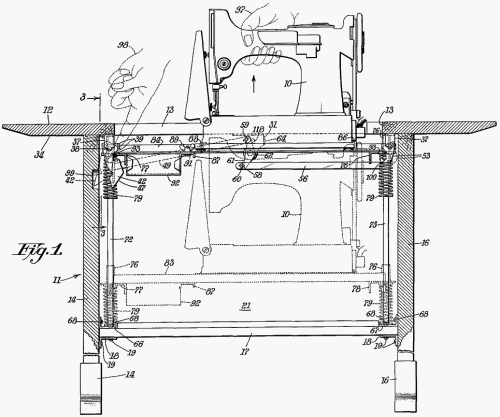
Daniel Chasen's patent application
After looking fruitlessly in all the traditional places, I realized this cabinet was something to really keep an eye out for. My vigilance was eventually rewarded in a little consignment shop known more for the bins of cheap, very old tools than its furniture; jokingly characterized as "put out vintage, finally sold antique".

Ready to Sew
I noticed that a huge armoire that had dominated the back of the room since forever, must have been sold. Revealed by its absence - it caught my eye right off - under some lacework, an old wool blanket, dishes and a lamp - there it was. Only a bit of the cabinet was exposed, but a shape & color that was immediately identifiable - the side panel/leg and foot. Peeking under the blanket, I opened the door, saw the spool rack, cleared the table of its fabric shroud and was greeted with a Singer model 68 cabinet in very good condition. I just picked it up and carried it to the desk. Not being a self-service place, they were a bit surprised.
When I got home I inspected the cabinet and the lift mechanism. It seemed, at that time, that there was no real documentation or mention of it any place. As there had been a cabinet which looked like mine auctioned at last year's ISMACS Convention, I consulted Graham Forsdyke who agreed I had an interesting find, though he wasn't overly familiar with the lift mechanism.
Shortly afterwards, I received from Norm Becker a comprehensive survey (the AD-68 Project) which was designed to garner all of the statistical data that AD Featherweight and 68 cabinet owners might provide (it turns out that Norm was also the auction winner of the Singer 68 cabinet with lift at the ISMACS convention). Norm has since confirmed that, based on the response to his survey, he and I are the only two indicated that currently own this cabinet.
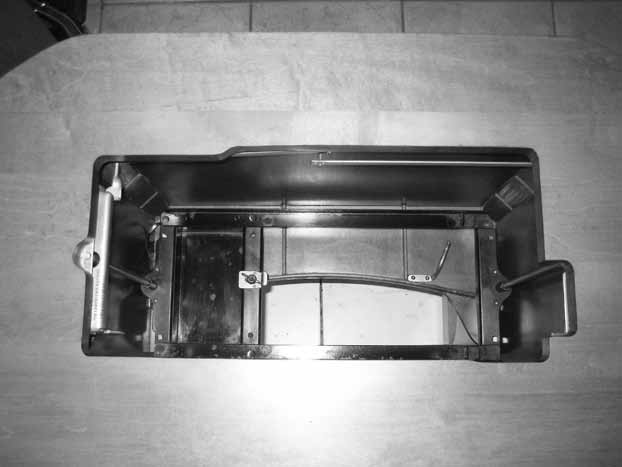
The lift, lowered, from above
After cleaning the cabinet and sewing on it a few times, I became curious to understand why such considerable expense would be incurred by a successful company to create an eclectic cabinet for the sole purpose of housing an optimally portable sewing machine. It just seemed odd. And then to fit a mechanical lift-assist mechanism for a portable which weighs next to nothing, generated even more questions.
Apart from a 1951 sale booklet, showing the model 68 cabinet with the lift, I could find no real mention of the mechanism in trade literature, so I checked for SIMANCO part numbers on the components of the lift.
I found them. EVERY part of the lift mechanism with the exception of the two steel rods, the two springs and the screws, had part numbers stamped into them; even the smallest spring retention clips. Remarkably, all the part numbers were specific to this cabinet. The spool rack and electric wire cleat were too, and shared the same serial number prefix: 1363. The only metal item without this prefix was the oil can holder. It is a standard part from any Singer cabinet in the 1940-50s.
A former research assistant and dear friend found the patent for the lift mechanism - the first of many Singer patents that I would pore over to better understand this cabinet.
So, after all of this I have come to a few conclusions of my own. The lift mechanism is, in fact, a patented, part numbered, componentbased, Singer manufactured product, designed and made for the transport of a Featherweight sewing machine from the stored position to the sewing position and back again, specifically in the model 68 cabinet. The manufacture of the model 68, incorporating the lift mechanism came almost immediately upon the heels of the design and manufacture of the cabinet itself, as suggested by the patent dates.
There was no patent issued for any other style of the model 68 cabinet without a lift mechanism. One could infer from this that the lift mechanism was discontinued, most probably, as a cost-saving measure and the substitute construct - of tray and shelf - did not require a patent because it was not seen as a forward enterprise but, rather, a stop-gap until discontinuation of the cabinet altogether.
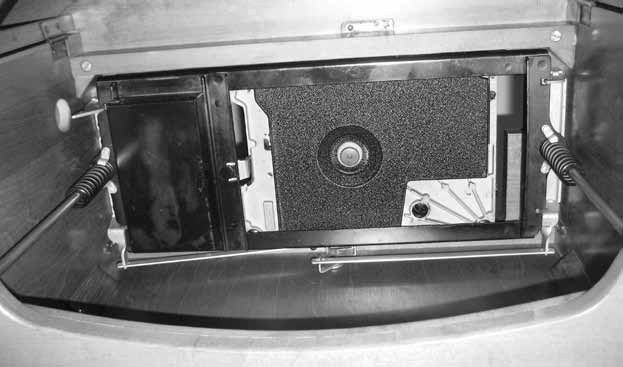
The lift, raised, from below
I subsequently came across two other Singer patents for cabinets which were specifically for the 221 Featherweight. One of these cabinets is cited in the patent application for the model 68 cabinet with lift but I don't know whether either of these other cabinets were ever manufactured. For me, the one question that remains unanswered and perhaps even more glaringly in light of this research, is why the 68 cabinet with lift mechanism is so rare today. Was it such a costly and failing enterprise that it was discontinued almost immediately?
That would be speculation. These, however, are the facts. A simple, two-page patent for the design of what was to become the first Model 68 cabinet was applied for by Joseph Ray, assignor to the Singer Manufacturing Company, on December 22, 1945 and granted February 18, 1947 (#146,383). The patent application, illustration and description presented the Featherweight cabinet that we are familiar with today, without mention of the top being removable or any explanation of how a machine would be used in conjunction with the cabinet. A second patent was applied for relating to this same cabinet in construction, in fact, referring to it by patent number and description in the new application (#697,139; September 14, 1946), submitted by Daniel H. Chasen.
Granted on November 13, 1951 (#2,575,045), it was considerably more detailed than the first. Seven pages in total, three of which were complex technical drawings of a mechanical lift system which was to be incorporated into the cabinet described in the first patent and shows a 221 being transported by the mechanism (see page 26).
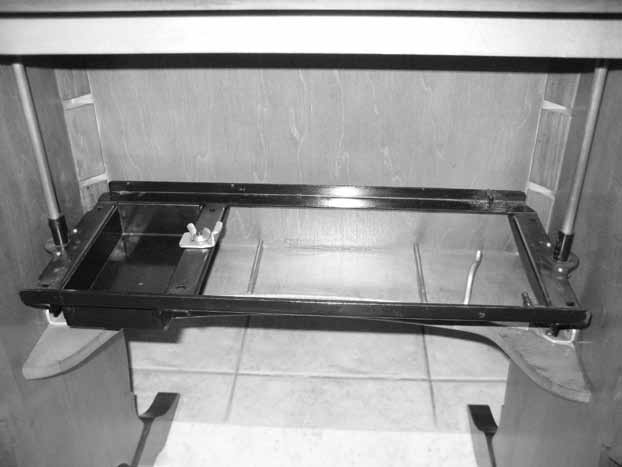
The lift, lowered into cabinet
The close proximity of the dates of the initial submission for first patent of the cabinet and the submission for patent of the lift seems to beg consideration that not only was this lift intentionally manufactured by Singer for the model 68 cabinet, but that it was embarked upon from the outset.
Upon further investigation of Singer cabinet patents from the 1940s to late 1950s, this doublefiling seems to have been standard practice.
A patent application illustrating and describing the look of the cabinet was submitted; followed, some time later, by another describing particulars of the interaction between sewing machine, operator and, in some cases, sundries. An example of this is another Featherweight-specific cabinet that was patented in the same time-frame. W.A. Davidson applied for and received a patent using a simple illustration and one-paragraph description as Application #122,819 (October 13, 1945), Patent #145,998 (December 3, 1946).
Subsequently, a second patent was sought - based on the previously mentioned and patented cabinet - for what was, in essence, the same general construct and aesthetic. This application is dated November 21, 1945, (#629,960) - just one month after the original submission for the cabinet - and was much more technically detailed both in written description and illustration. The patent was granted to W.A. Davidson, with Singer, again, the Assignee. (#2,558,826; July 3, 1951). Was this particular Featherweight cabinet manufactured and if so, do any still exist?
Maybe the real mystery of any cabinet manufactured for the Singer Featherweight lies in the evolution of its very existence rather than the marketing of the actual furniture that attempted to formally house our defiant portable.
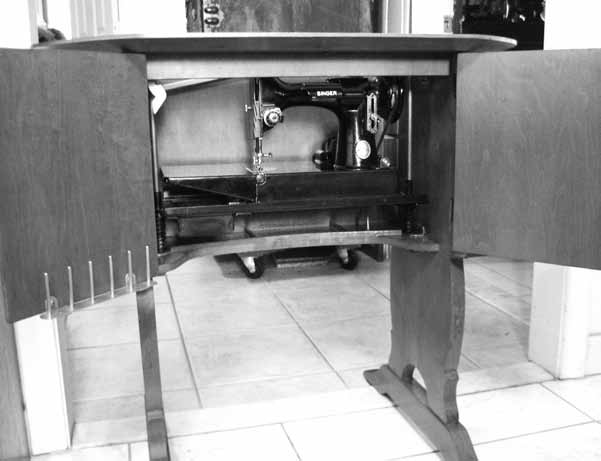
J.D. Leedham
www.sewitsold.com
Thanks to Joe Tricarico, Norm Becker, Graham Forsdyke and my anonymous research assistant






